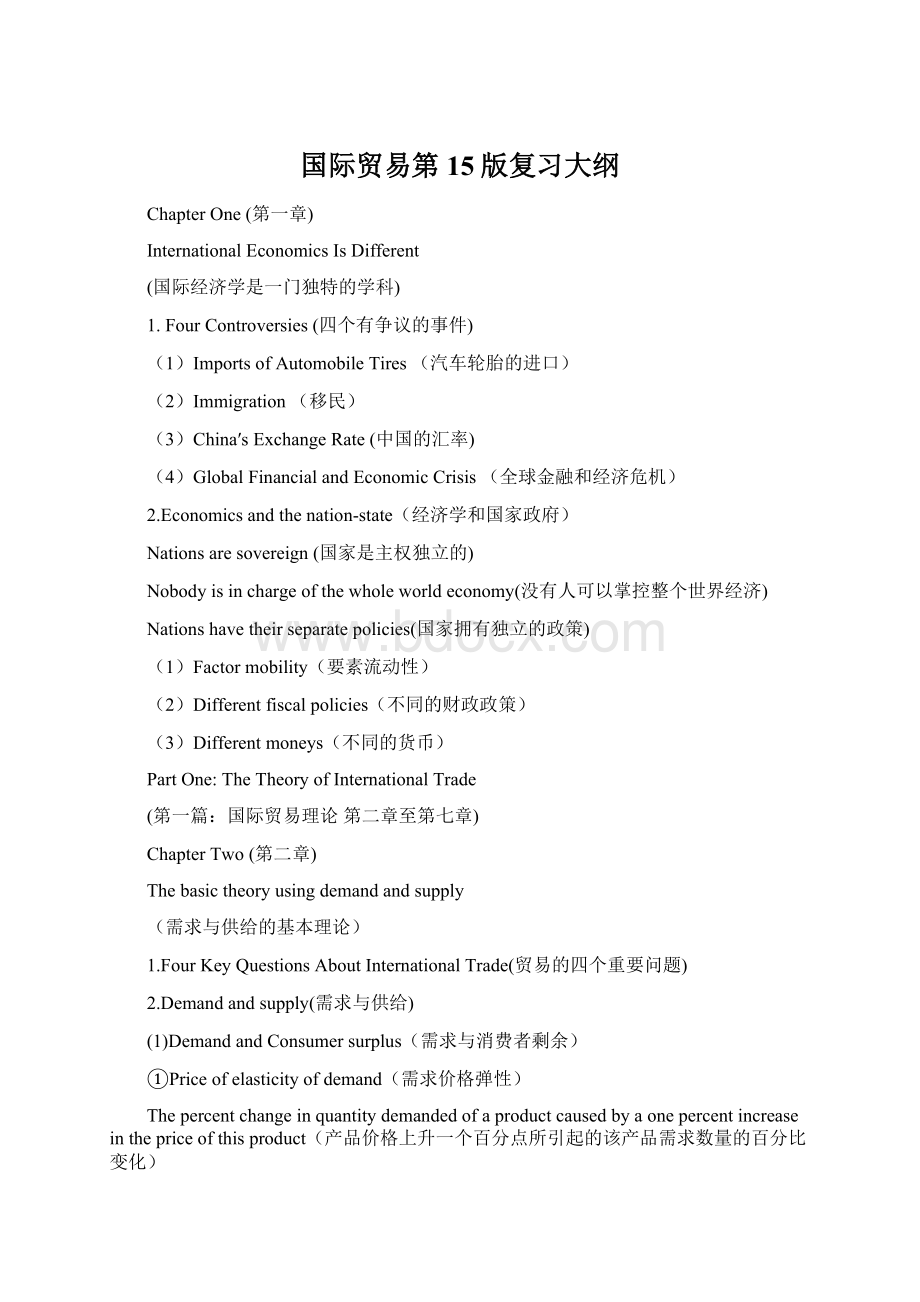国际贸易第15版复习大纲.docx
《国际贸易第15版复习大纲.docx》由会员分享,可在线阅读,更多相关《国际贸易第15版复习大纲.docx(26页珍藏版)》请在冰豆网上搜索。

国际贸易第15版复习大纲
ChapterOne(第一章)
InternationalEconomicsIsDifferent
(国际经济学是一门独特的学科)
1.FourControversies(四个有争议的事件)
(1)ImportsofAutomobileTires(汽车轮胎的进口)
(2)Immigration(移民)
(3)China′sExchangeRate(中国的汇率)
(4)GlobalFinancialandEconomicCrisis(全球金融和经济危机)
2.Economicsandthenation-state(经济学和国家政府)
Nationsaresovereign(国家是主权独立的)
Nobodyisinchargeofthewholeworldeconomy(没有人可以掌控整个世界经济)
Nationshavetheirseparatepolicies(国家拥有独立的政策)
(1)Factormobility(要素流动性)
(2)Differentfiscalpolicies(不同的财政政策)
(3)Differentmoneys(不同的货币)
PartOne:
TheTheoryofInternationalTrade
(第一篇:
国际贸易理论第二章至第七章)
ChapterTwo(第二章)
Thebasictheoryusingdemandandsupply
(需求与供给的基本理论)
1.FourKeyQuestionsAboutInternationalTrade(贸易的四个重要问题)
2.Demandandsupply(需求与供给)
(1)DemandandConsumersurplus(需求与消费者剩余)
①Priceofelasticityofdemand(需求价格弹性)
Thepercentchangeinquantitydemandedofaproductcausedbyaonepercentincreaseinthepriceofthisproduct(产品价格上升一个百分点所引起的该产品需求数量的百分比变化)
注意:
需求曲线越平坦,说明越具有价格弹性
②Consumersurplus(消费者剩余)
Thedifferencebetweenthevaluethatconsumersplaceontheunitsoftheproductthattheybuyandthepaymentthattheymaketoobtaintheseunits.(消费者在每单位产品上愿意支付的价格与获得这些产品实际支付的价格之间的差额)
(2)Supplyandproducersurplus(供给与生产者剩余)
①Priceofelasticityofsupply(P20)
②Supplysurplus(figure2.1)(P22)
3.Twonationalmarketsandtheopeningoftrade(两国的市场与贸易的开展)
(1)FreeTradeEquilibrium(自由贸易均衡)
WhatwillhappenwhenUStradewiththerestofcountry?
Buylowandsellhigh-----arbitrage(套利)
Note:
one–dollar,one-votemetric(一元一票制)
(2)Whichcountrygainsmore?
(哪个国家获益更多)
Thecountrythatexperiencesthelargerpricechangehasalargervalueofthenetgainsfromtrade(经历较大价格变化的国家从贸易中获得较大的净收益)
ChapterThree(第三章)
WhyEverybodyTrades:
ComparativeAdvantage
(为什么开展贸易:
比较优势)
1.Adamsmith′stheoryofabsoluteadvantage(斯密的绝对优势理论)
(1)Mercantilism(重商主义)(P35)
(2)Thetheoryofabsoluteadvantage
Everycountrywillfocusonproducingwhatitdoesbestandexportsit。
(各国将集中力量生产它最擅长的产品并出口它)
1Howtomeasure“best”?
Laborproductivity:
劳动生产率
Thenumberofunitsofoutputthataworkercanproduceinonehour。
Orthenumberofhoursthatittakesaworkertoproduceoneunitofoutput。
②Thebasisoftrade(贸易的基础)
Thereisabasisforbeneficialtradeifcountrieshaveanabsoluteadvantage(如果一国具有绝对优势那么从事贸易是有利的)
2.Ricardo′sTheoryofcomparativeadvantage(李嘉图的比较优势理论)
(1)Themainviews(主要观点)
①Ricardofocusedonlaborproductivity(orresourceproductivitymoregenerally)fordifferentproductsindifferentcountries.
②Theprincipleofcomparativeadvantage:
Acountrywillexportproductsthatitcanproduceatalowopportunitycostandimportproductsthatitwouldotherwiseproduceatahighopportunitycost.
③Basisfortrade:
Relativedifferencesinlabor(resource)productivity.
(2)Concepts(概念)
①Opportunitycost(机会成本)
Producingmoreofaproductinacountryistheamountofproductionoftheotherproductthatisgiveup.(一国某种产品多生产一单位是其它产品所放弃的生产数量)
②Relativeprice(相对价格)
3.Ricardo′sconstantcostsandtheproduction-possibilitycurve(ppc)
(1)PPCunderconstantcosts(固定成本下的生产可能性曲线)
Acurvethatshowsallpossiblecombinationsofamountsofdifferentproductsthataneconomycanproduce,withfullemploymentofitsresourcesandmaximumfeasibleproductivityofthoseresources。
(一个经济体在资源充分就业以及资源生产率最大化条件下能够生产的不同产品数量的各种组合的曲线)
(2)Constantproductivity(P41)
Themarginaloropportunitycostofeachgoodisconstantineachcountry.
(3)Ricardo′sconclusion
Eachcountrythenspecializesinproducingonlythegoodinwhichithasacomparativeadvantage.(各国仅仅专业化生产自身具有比较优势的产品)
(4)Equilibriuminternationalpriceratio(国际均衡价格比率)
Mustfallwithintherangeofthetwopriceratiosthatprevailedineachcountrybeforetradebegan.(必定位于贸易开始前两国产品的相对价格比率的区间内)
2.1>=internationalpriceofcloth>=0.67(bushel/yard)
0.5<=internationalpriceofwheat<=1.5(yard/bushel)
ChapterFour(第四章)
Trade:
Factoravailabilityandfactorproportionsarekey
(贸易:
要素可获取性和要素比例是关键)
Review:
回顾前几章thebasesoftrade(贸易的基础)
First,thedifferencesinthedemandsforproductsindifferentcountries(第一,不同国家产品的需求差异)
Second,thedifferencesintechnologiesorresourceproductivitiescancreatecomparativeadvantage(第二,产生比较优势的技术或资源生产率的差异)
Third,thedifferencesinfactoravailabilityareasourceofcomparativeadvantage(第三,产生比较优势的要素可获取性的差异)(本章重点)
1.Productionwithincreasingmarginalcosts(边际成本递增下的生产)
(1)IncreasingmarginalcostP50
Asoneindustryexpandsitsproductionquantity,increasingamountsofotherproductsmustbegivenuptogeteachextraunitoftheexpandingindustry'sproduct
(2)Isitstraightlineasconstantcost?
(固定成本的PPC线是一条直线吗?
)
Productionpossibilitiescurveunderincreasingcostsisbowedout
(边际成本递增下的生产可能性曲线是凸向原点的形状)
(3)Whatproductioncombinationisactuallychosen?
(如何选择实际的生产组合)
●Specializationononlyoneproductinconstantcostcase.(在固定成本情形下只专业化生产一种产品)
●Itdependsonthemarketprice.(实际的生产组合取决于市场价格)
2.Communityindifferencecurves(社会无差异曲线)P53
(1)IndifferencecurvesP53
Acurvethatshowsthevariouscombinationsofconsumptionquantitiesofproductsthatgiveaconsumerthesamelevelofwell-beingorhappiness。
(2)Whatconsumptioncombinationisactuallychosen?
(如何选择实际的消费组合)
Dependonthebudgetconstrain.(取决于预算约束)
3.Productionandconsumptiontogether(生产和消费相结合P55-56)
(1)WithouttradeP55图
(2)WithtradeP56
(3)DemandandsupplyagainP56
4.Thegainsfromtrade(贸易的利益)
●Tradeallowseachcountrytoconsumeatapoint(C1)thatliesbeyonditsownpossibilitytoproduce;
●tradeallowseachcountrytoachieveahighercommunityindifferencecurve
●Acountrygainsmorefromtradeifitstermsoftradeincrease.
¡Termsoftrade(贸易条件):
theratioofthe(average)pricethatacountryreceivesfromforeignersforitsexportstothe(average)pricethatthiscountrypaysforeignersforitsimports(贸易条件是指一国从出口中收取的价格与向进口品支付的价格之间的比率)
5.Tradeaffectsproductionandconsumption(贸易影响生产和消费)
6.Whatdeterminesthetradepattern?
(什么决定贸易模式)
●Productionconditionaldiffer
●Consumptionconditionaldiffer
●Somecombinationofthesetwodifferences
7.Heckscher-OhlinTheoryofTrade(赫克歇尔-俄林理论)
(1)Labor-abundantandLabor-intensive(劳动力丰裕和劳动力密集)
Labor-abundant(劳动力丰裕):
Arelativelylaborabundantcountryisacountrythathasahigherratioof(nationallyavailable)laborto(nationallyavailable)otherfactorsthandoestherestoftheworld.
Labor-intensive(劳动力密集):
Arelativelylabor-intensiveproductisaproductforwhichlaborcostsareagreatershareofitsvaluethantheyareofthevalueofotherproducts
(2)mainviews(主要观点)
Acountrywillexportproductsthatuserelativelyintensivelythoseproductionfactorsfoundrelativelyabundantlyinthecountry,andimportproductsthatuserelativelyintensivelythoseproductionfactorsthatarerelativelyscarceinthecountry.(一国应该出口密集使用该国相对丰裕要素生产的产品,并且进口密集使用该国相对稀缺要素生产的产品)
ChapterFive(第五章)
WhoGainsandWhoLosesfromTrade?
(贸易中谁受益?
谁受损?
)
1.Whogainsandwholoseswithinacountry(一国内部谁受益谁受损)
(1)Short-runeffectsofopeningtrade(开展贸易的短期效应)
Gainsandlossesdividedbyoutputsector:
allgroupstiedtorisingsectorsgain,andallgroupstiedtodecliningsectorslose.(按照产出的产业来划分受益和受损:
与上升产业相联系的所有群体受益,与缩减产业相联系的所有群体受损)
(2)Long-runeffectsofopeningtrade(开展贸易的长期效应)
Gainsandlossesdividedbyfactors:
factorwhichisintensivelyusedintheexportgains,andfactorwhichissparingusedintheexportlose.(按照要素来划分受益和受损:
在出口中密集使用的要素受益,在出口中稀缺使用的要素受损)
2.ThreeimplicationoftheH-Otheory(H-O理论的三种意义)
(1)TheStopler-Samuelsontheorem(S-Stheorem)(斯托尔珀-萨缪尔森定理)
●Itraisestherealreturntothefactorusedintensivelyintherising-priceindustry;itlowerstherealreturntothefactorusedintensivelyinthefallingpriceindustry
(2)Thespecialized-factorpattern(专业化要素模式)
●Themoreafactorisspecializedintheproductionofaproductwhoserelativepriceisrising,themorethisfactorstandstogainfromthechangeintheproductprice
●Themoreafactorisconcentratedintotheproductionofaproductwhoserelativepriceisfalling,themoreitstandstolosefromthechangeinproductprice
(3)Thefactor-priceequalizationtheorem(要素均等化定理)
¡InternationalFactorPriceEqualization
●Withtheshifttofreetrade:
Foreachfactor,itsrateofreturnbecomesmoresimilarbetweencountries.Underidealconditions,itsrealrateofreturnisthesameindifferentcountries.
3.DoesH-Oexplainactualtradepatterns?
(H-O理论能解释现实的贸易模式吗?
)
(1)Leotiefparadox(readingbox)(里昂惕夫之谜)(阅读专栏P75)
USeconomyassumedcapital-abundantrelativetotherestoftheworld.Leotief′sresultsshowedthatuswasexportinglabor-intensivegoodstotherestoftheworldinexchangeforrelativelycapital-intensiveimports.
(2)SomeexplanationsaboutLeotiefparadox(里昂惕夫之谜的解释)
●Factorendowments(要素禀赋)
●internationaltrade(国际贸易)
4.Whataretheexport-orientedandimport-competingfactors?
(什么是出口导向型和进口竞争型要素?
)
(1)Itsimplicationsinpolicy(它的政策含义)
Figure5.5–ASchematicViewoftheFactorContentofU.S.ExportsandCompetingImports
Figure5.6-TheFactorContentofCanada’sExportsandCompetingImports
5.Dofactorpricesequalizeinternationally?
(国际间要素价格会均等吗?
)
Althoughwestilldonotseefullfactor-priceequalizationintherealworld,thereappeartobeatendencytowardinternationalfactor-priceequalization.(尽管在现实世界我们仍然没有看到完全的要素价格均等化,但是似乎存在一种要素价格均等化的趋势)
ChapterSix(第六章)
ScaleEconomies,ImperfectCompetition,andTrade
(规模经济,不完全竞争和贸易)
1.Economiesofscale(规模经济)
(1)Internaleconomiesofscale(内部规模经济)
Internalscaleeconomies:
Expansionofthesizeoftheindividualfirmisthebasisforthedeclineinaveragecostasthefirm'sproductionquantityincreases.
(2)Externaleconomiesofscale(外部规模经济)
Externalscaleeconomiesoragglomeration